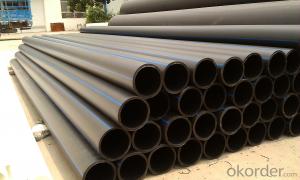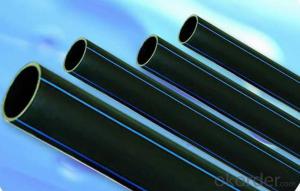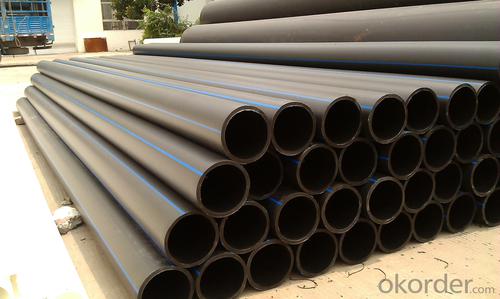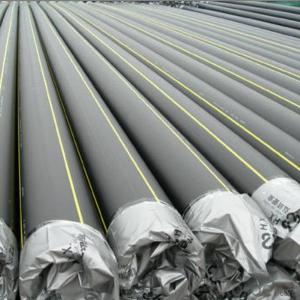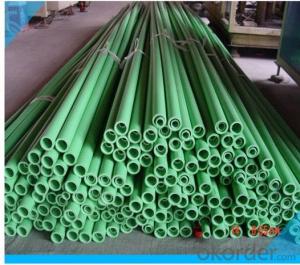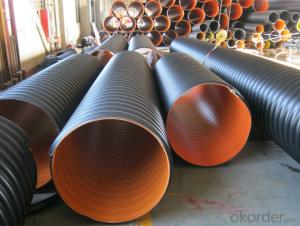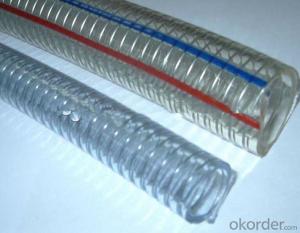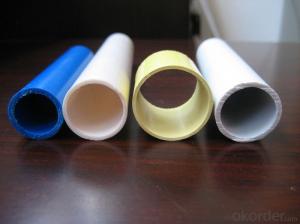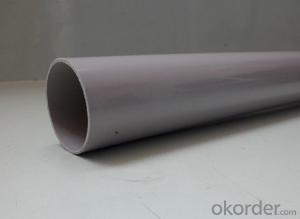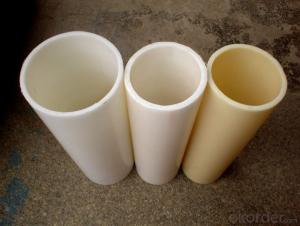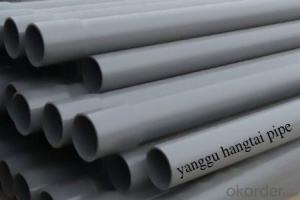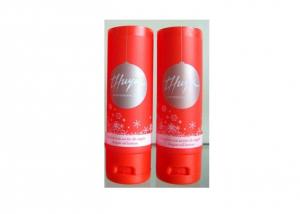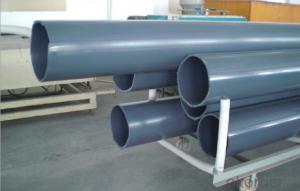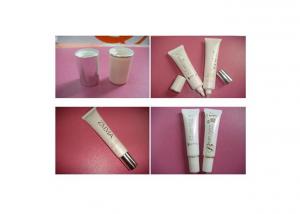HDPE Plastic Tubes GB/T13663-2000 DN110
- Loading Port:
- China Main Port
- Payment Terms:
- TT OR LC
- Min Order Qty:
- -
- Supply Capability:
- -
OKorder Service Pledge
OKorder Financial Service
You Might Also Like
Physical properties[edit]
Polyethylene is a thermoplasticpolymer consisting of long hydrocarbon chains. Depending on the crystallinity and molecular weight, a melting point and glass transition may or may not be observable. The temperature at which these occur varies strongly with the type of polyethylene. For common commercial grades of medium- and high-density polyethylene the melting point is typically in the range 120 to 180 °C (248 to 356 °F). The melting point for average, commercial, low-density polyethylene is typically 105 to 115 °C (221 to 239 °F).it is transprant.
Chemical properties[edit]
Most LDPE, MDPE and HDPE grades have excellent chemical resistance, meaning that it is not attacked by strong acids or strong bases. It is also resistant to gentle oxidants and reducing agents. Polyethylene burns slowly with a blue flame having a yellow tip and gives off an odour of paraffin. The material continues burning on removal of the flame source and produces a drip.[3] Crystalline samples do not dissolve at room temperature. Polyethylene (other than cross-linked polyethylene) usually can be dissolved at elevated temperatures in aromatic hydrocarbons such as toluene or xylene, or in chlorinated solvents such as trichloroethane or trichlorobenzene.[4]
GB/T13663-2000:
| PE63管材规格 | |||||
| 公称 外径dn,mm | SDR33 | SDR26 | SDR17.6 | SDR13.6 | SDR11 |
| 公称压力 PN,Mpa | |||||
| 0.32 | 0.4 | 0.6 | 0.8 | 1.0 | |
| 公称 壁厚 | 公称 壁厚 | 公称 壁厚 | 公称 壁厚 | 公称 壁厚 | |
| 16 | 2.3 | ||||
| 20 | 2.3 | 2.3 | |||
| 25 | 2.3 | 2.3 | 2.3 | ||
| 32 | 2.3 | 2.4 | 2.9 | ||
| 40 | 2.3 | 2.3 | 3.0 | 3.7 | |
| 50 | 2.3 | 2.9 | 3.7 | 4.6 | |
| 63 | 2.3 | 2.5 | 3.6 | 4.7 | 5.8 |
| 75 | 2.3 | 2.9 | 4.3 | 5.6 | 6.8 |
| 90 | 2.8 | 3.5 | 5.1 | 6.7 | 8.2 |
| 110 | 3.4 | 4.2 | 6.3 | 8.1 | 10.0 |
| 125 | 3.9 | 4.8 | 7.1 | 9.2 | 11.4 |
| 140 | 4.3 | 5.4 | 8.0 | 10.3 | 12.7 |
| 160 | 4.9 | 6.2 | 9.1 | 11.8 | 14.6 |
| 180 | 5.5 | 6.9 | 10.2 | 13.3 | 16.4 |
| 200 | 6.2 | 7.7 | 11.4 | 14.7 | 18.2 |
| 225 | 6.9 | 8.6 | 12.8 | 16.6 | 20.5 |
| 250 | 7.7 | 9.6 | 14.2 | 18.4 | 22.7 |
| 280 | 8.6 | 10.7 | 15.9 | 20.6 | 25.4 |
| 315 | 9.7 | 12.1 | 17.9 | 23.2 | 28.6 |
| 355 | 10.9 | 13.6 | 20.1 | 26.1 | 32.2 |
| 400 | 12.3 | 15.3 | 22.7 | 29.4 | 36.3 |
| 450 | 13.8 | 17.2 | 25.5 | 33.1 | 40.9 |
| 500 | 15.3 | 19.1 | 28.3 | 36.8 | 45.4 |
| 560 | 17.2 | 21.4 | 31.7 | 41.2 | 50.8 |
| 630 | 19.3 | 24.1 | 35.7 | 46.3 | 57.2 |
- Q: Are plastic tubes resistant to impact?
- Yes, plastic tubes are generally resistant to impact due to their flexible and durable nature.
- Q: What is the hard plastic material?
- PPS, the Chinese name is pps. The utility model has the advantages of hard and crisp, high crystallinity, burning resistance, good thermal stability, high mechanical strength, good electrical performance, etc..
- Q: How empty do you get the toothpaste tube before you will throw it out?
- Flat empty...no use wasting product.
- Q: I've also seen oxygen masks with tubes hooked up to them? And tubes in the nose?
- The plastic thing is a nasal cannula, which is good for supplementary oxygen. An oxygen mask allows doctors to deliver a higher, more concentrated dose of oxygen to a patient. A breathing tube is inserted when a patient cannot breathe sufficiently on her own, and she is connected to a ventilator, which breathes for her until she is strong enough to breathe on her own.
- Q: Quality inspection station said that the ceiling does not let go PVC tube, I did not find evidence
- In the regulations of the old people's regulations, the "hard burning type" plastic pipe wiring can be used in the building ceiling." Plastic bellows should not be used".
- Q: What is a paintball power tube used for?Im looking into an tippmann A5 power tube Delrin Front Bolt. Whats the difference and benefits.Thanks
- The power tube is the part that holds the valve in the marker and helps direct air flow. Getting a new power tube will do NOTHING to performance. It has no performance valve what so ever. The front bolt is the part that helps push the ball out or the chamber. And getting a new one will help very very lil. So lil that it doesn't really matter. THis is because the stock front bolt on the tippmann markers is made so well that changing it doesn't make it any better because they will perform just about the same. Replacing the stock power tube to a full aluminum power tube is a good idea because after a while the stock plastic power tube does tend to break and when that happens it will cause air or co2 to leak. The aluminum one wont do that and lasts a lot longer.
- Q: PVC flame retardant pipes have three kinds of ABC, heavy duty is not rigid flame retardant tube?
- The rigid flame retardant tube is usually made of white hard material. It is refractory and connected directly with the head or screw joint. The diameter of the small tube can be bent by spring. It is the most widely used electric threading pipe in plastic pipes.
- Q: Can plastic tubes be used for greenhouse construction?
- Yes, plastic tubes can be used for greenhouse construction. They are often used as a cost-effective alternative to traditional materials such as metal or wood. Plastic tubes are lightweight, easy to handle, and resistant to weather and corrosion, making them suitable for greenhouse structures. Additionally, their flexibility allows for creative designs and easy installation.
- Q: Are plastic tubes recyclable?
- Yes, plastic tubes are recyclable. However, it is important to check with your local recycling facility to ensure that they accept plastic tubes for recycling, as some facilities may have specific guidelines or limitations.
- Q: I want to get a gerbil and i want to get a plastic cage with tubes but i heard that they can claw threw the cage so i was wondering why they do this and how long does it take
- You're right, plastic is not good for them. I recommend getting an aquarium (I have a 55 gallon myself). For two gerbils a 20 gallon would be okay, but the bigger the better. Fill the aquarium with wood toys and cardboard (hideouts, playground, etc). Trixie Pet products are nice for gerbils. I know the CritterTrail habbitats look nice but they are not worth it. The gerbils can get sick/hurt from the plastic and there isn't adequate space. Good luck.
Send your message to us
HDPE Plastic Tubes GB/T13663-2000 DN110
- Loading Port:
- China Main Port
- Payment Terms:
- TT OR LC
- Min Order Qty:
- -
- Supply Capability:
- -
OKorder Service Pledge
OKorder Financial Service
Similar products
Hot products
Hot Searches
Related keywords
